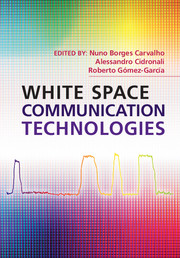Book contents
- Frontmatter
- Contents
- List of contributors
- Preface
- List of abbreviations
- Part I White space technology signal processing and digital design
- Part II Adaptable receivers for white space technologies
- 4 Reconfigurable RF front-ends for cognitive and software-defined radio
- 5 Filtering stages for white space cognitive/software-defined radio receivers
- 6 Subsampling multi-standard receiver design for cognitive radio systems
- Part III Adaptable transceivers for white space technologies
- Index
- References
6 - Subsampling multi-standard receiver design for cognitive radio systems
from Part II - Adaptable receivers for white space technologies
Published online by Cambridge University Press: 05 October 2014
- Frontmatter
- Contents
- List of contributors
- Preface
- List of abbreviations
- Part I White space technology signal processing and digital design
- Part II Adaptable receivers for white space technologies
- 4 Reconfigurable RF front-ends for cognitive and software-defined radio
- 5 Filtering stages for white space cognitive/software-defined radio receivers
- 6 Subsampling multi-standard receiver design for cognitive radio systems
- Part III Adaptable transceivers for white space technologies
- Index
- References
Summary
Introduction
Cognitive radio (CR), as coined and defined by its first proponent, is the integration of model-based reasoning with software radio techniques [1]. An important aspect of cognitive radio is the efficient use of resources, especially the frequency spectrum, in a typical communication environment. Spectrum management requires spectrum sensing; the subsampling technique has been demonstrated to be an efficient approach for spectrum sensing for CR applications [2]. Cognitive radio technology, in the context of white space, has been discussed in Chapter 1 of this book. Situation awareness and learning capability are some of the features in a CR through which it becomes aware of the location, radio frequency (RF) environment, and updates its knowledge. Environmental information in a CR is typically provided by an in-built or network-enabled radio environment map (REM) through some learning process. A typical CR node consists of the RF front-end and configurable hardware and software platform. The current software-defined radio (SDR) platforms will facilitate the evolution of CR by adding cognitive and intelligent features to it with the help of cognitive engines (CE). Cognitive engines are essentially the software packages that facilitate the cognitive feature to an agile radio platform.
A software-defined radio (SDR) is a radio that can accommodate a significant range of RF bands and air interface modes through software [1]. An ideal SDR receiver will sample and digitize the RF signals as close as possible to the receiver antenna.
Information
- Type
- Chapter
- Information
- White Space Communication Technologies , pp. 167 - 196Publisher: Cambridge University PressPrint publication year: 2014
